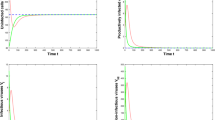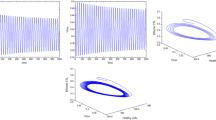Abstract
The minimum duration of treatment periods and the optimal multidrug therapy for human immunodeficiency virus (HIV) type 1 infection are considered. We formulate an optimal tracking problem, attempting to drive the states of the model to a “healthy” steady state in which the viral load is low and the immune response is strong. We study an optimal time frame as well as HIV therapeutic strategies by analyzing the free terminal time optimal tracking control problem. The minimum duration of treatment periods and the optimal multidrug therapy are found by solving the corresponding optimality systems with the additional transversality condition for the terminal time. We demonstrate by numerical simulations that the optimal dynamic multidrug therapy can lead to the long-term control of HIV by the strong immune response after discontinuation of therapy.
Similar content being viewed by others
References
Adams, B. M., Banks, H. T., Kwon, H. D., & Tran, H. T. (2004). Dynamic multidrug therapies for HIV: Optimal and STI control approaches. Math. Biosci. Eng., 1, 223–241.
Adams, B. M., Banks, H. T., Davidian, M., Kwon, H. D., Tran, H. T., Wynne, S. N., & Rosenberg, E. S. (2005). HIV dynamics: modeling, data analysis, and optimal treatment protocols. J. Comput. Appl. Math., 184, 10–49.
Adams, B. M., Banks, H. T., Davidian, M., & Rosenberg, E. S. (2007). Estimation and prediction with HIV treatment interruption data. Bull. Math. Biol., 69, 563–584.
Alvarez-Ramirez, J., Meraz, M., & Velasco-Hernandez, J. X. (2000). Feedback control of the chemotherapy of HIV. Int. J. Bifurc. Chaos Appl. Sci. Eng., 10, 2207–2219.
Bajaria, S. H., Webb, G., & Kirschner, D. E. (2004). Predicting differential responses to structured treatment interruptions during HAART. Bull. Math. Biol., 66, 1093–1118.
Banks, H. T., Kwon, H.-D., Toivanen, J. A., & Tran, H. T. (2006). A state-dependent Riccati equation-based estimator approach for HIV feedback control. Optim. Control Appl. Methods, 27, 93–121.
Banks, H. T., Davidian, M., Hu, S., Kepler, G. M., & Rosenberg, E. S. (2008). Modeling HIV immune response and validation with clinical data. J. Biol. Dyn., 2, 357–385.
Bonhoeffer, S., Rembiszewski, M., Ortiz, G. M., & Nixon, D. F. (2000). Risks and benefits of structured antiretroviral drug therapy interruptions in HIV-1 infection. AIDS, 14, 2313–2322.
Brandt, M. E., & Chen, G. (2001). Feedback control of a biodynamical model of HIV-1. IEEE Trans. Biomed. Eng., 48, 754–759.
Callaway, D. S., & Perelson, A. S. (2001). HIV-1 infection and low steady state viral loads. Bull. Math. Biol., 64, 29–64.
Dai, Y. H., Liao, L. Z., & Li, D. (2004). On restart procedures for the conjugate gradient method. Numer. Algorithms, 35, 249–260.
Fister, K. R., Lenhart, S., & McNally, J. S. (1998). Optimizing chemotherapy in an HIV model. Electron. J. Differ. Equ., 32, 1–12.
Fleming, W. H., & Rishel, R. W. (1975). Deterministic and stochastic optimal control. New York: Springer.
Gilbert, J. C., & Nocedal, J. (1992). Global convergence properties of conjugate gradient methods for optimization. SIAM J. Optim., 2(1), 21–42.
Kamien, M. I., & Schwartz, N. L. (1991). Dynamic optimization. Amsterdam: North-Holland.
Kirschner, D., Lenhart, S., & Serbin, S. (1997). Optimal control of the chemotherapy of HIV. J. Math. Biol., 35, 775–792.
Lasdon, L. S., Mitter, S. K., & Waren, A. D. (1967). The conjugate gradient method for optimal control problems. IEEE Trans. Autom. Control, AC-12(2), 132–138.
Lisziewicz, J., & Lori, F. (2002). Structured treatment interruptions in HIV/AIDS therapy. Microbes Infect., 4, 207–214.
Lukes, D. L. (1982). Differential equations: classical to controlled, mathematics in science and engineering. San Diego: Academic Press.
Ogg, G. S., et al. (1998). Quantitation of HIV-1 specific cytotoxic T lymphocytes and plasma load of viral RNA. Science, 279, 2103–2106.
Pontryagin, L. S., Boltyanskii, V. G., Gamkrelidze, R. V., & Mishchenko, E. F. (1962). The mathematical theory of optimal processes. New York: Gordon and Breach.
Ruiz, L., et al. (2000). Structured treatment interruption in chronically HIV-1 infected patients after long-term viral suppression. AIDS, 14, 397–403.
Shi, Z. J., & Guo, J. (2008). A new algorithm of nonlinear conjugate gradient method with strong convergence. Comput. Math. Appl., 27, 93–106.
Shim, H., Han, S. J., Chung, C. C., Nam, S., & Seo, J. H. (2003). Optimal scheduling of drug treatment for HIV infection: Continuous dose control and receding horizon control. Int. J. Control. Autom. Syst., 1, 401–407.
Wodarz, D., & Nowak, M. A. (1999). Specific therapy regimes could lead to long-term immunological control of HIV. Proc. Natl. Acad. Sci. USA, 96, 14464–14469.
Author information
Authors and Affiliations
Corresponding author
Rights and permissions
About this article
Cite this article
Jang, T., Kwon, HD. & Lee, J. Free Terminal Time Optimal Control Problem of an HIV Model Based on a Conjugate Gradient Method. Bull Math Biol 73, 2408–2429 (2011). https://doi.org/10.1007/s11538-011-9630-z
Received:
Accepted:
Published:
Issue Date:
DOI: https://doi.org/10.1007/s11538-011-9630-z




